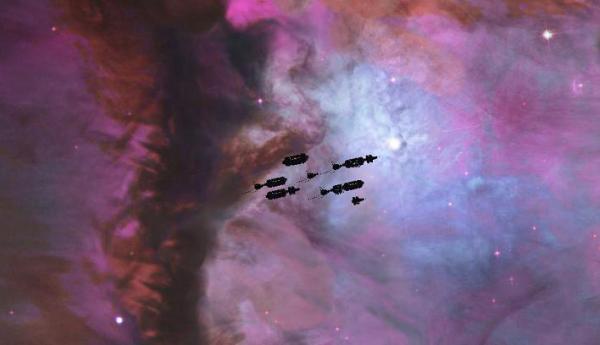BY LETTER
Drift
Galactography > Other Major Polities, Empires, and Meta-Empires > Hiders
Technology > Application > Infrastructure
Technology > Application > Infrastructure
Type of Backgrounder habitat or worldship designed to slowly travel across interstellar space | |
 Image from Steve Bowers | |
| Drifts are often too dim to see clearly even using large space telescope arrays while in deep space. This cluster drift has been captured in silhouette against the Orion Nebula. Each element of this drift is on the order of a thousand kilometers in length. | |
A drift may consist of a single large habitat, a cluster of habitats, or a shell of habitats surrounding a large mobile hotpoint. As a result they are some of the largest structures that Backgrounders may construct, sometimes measuring several tens of thousands of kilometers across. Propulsion is generally of very high efficiency with deep-space acceleration provided by plasma or ion drive, deceleration and direction changes via magnetic sail acting against the galactic magnetic field, and sometimes even fusion drives when a particularly large or swift alteration in heading is required. In addition many drifts will deploy large solar sails when passing near a star for the purpose of changing direction or velocity via gravity-assist maneuver and light-pressure.
Regardless of the exact form or structure of the drift itself, the defining characteristic of such craft is their method of travel. Drifts are multi-generational craft designed to operate almost exclusively in interstellar space, only occasionally passing near a star for the purpose of changing direction or harvesting resources.
The purpose of a drift is not to reach a particular destination but to provide its inhabitants with a permanent home that is independent of any single star (and perhaps more importantly from the perspective of many Backgrounders, independent of the ruling hand of the Sephirotic AIs).
Drifts are similar to many worldships in their method of operation and velocity regime (0.01 to 0.03c). However while a worldship may occasionally spend several decades or longer inside a solar system between voyages, drifts almost never come closer than several tens of AU to a star and never stay in the vicinity of a star system any longer than they absolutely have to.
The vast distance between individual drifts is a major contributory factor in the disjointed nature of the Backgrounder culture. Information, news, and cultural influence is very slow to spread from one drift to another, and the inhabitants of individual drifts rarely meet.
Related Articles
Appears in Topics
Development Notes
Text by Todd Drashner
Initially published on 19 September 2007.
Initially published on 19 September 2007.






